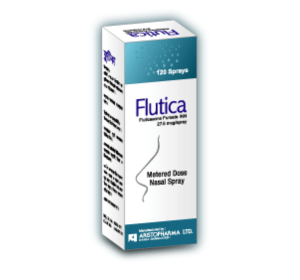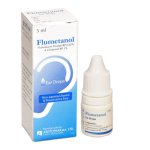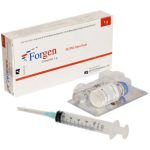Flutica (Fluticasone Furoate)

Therapeutic Group : Antihistamine & Decongestant
Presentation:
Flutica Nasal Spray: Each metered dose spray contains Fluticasone Furoate INN 27.5 mcg.
Flutica Cream: Each gram cream contains Fluticasone Propionate BP 0.5 mg.
Indications:
Flutica Nasal Spray is indicated for the treatment of symptoms of seasonal and perennial allergic rhinitis in adults and children above 2 years and for the prevention of recurrence of nasal polyps following surgical removal. Flutica Cream is indicated for the relief of the inflammatory and pruritic manifestations of corticosteroid-responsive dermatoses such as: eczema, psoriasis (excluding widespread plaque psoriasis), neurodermatoses, generalized erythroderma, insect bite reaction and prickly heat.
Dosage & Administration:
For intranasal use only. Adults and adolescents (12 years and over) The recommended starting dose is 2 sprays in each nostril once daily. Once adequate control of symptoms is achieved, dose reduction to one spray in each nostril once daily can be effective for maintenance.
Children (2 to 11 years of age): The recommended starting dose is 1 spray in each nostril once daily.
Flutica Cream Apply a thin film of Flutica Cream to the affected skin areas once or twice daily. Rub in gently.
Contrainidications:
Fluticasone Furoate is contraindicated for the patients who have hypersensitivity to any components of this preparation. Side effects: The most common side effects are headache, epistaxis, pharyngolaryngeal pain, nasal ulceration, back pain, pyrexia, and cough.
Flutica Cream: This topical cream is contraindicated in those patients with a history of hypersensitivity to any of the components in the preparation.
Warning & Precautions:
Patients taking Fluticasone Furoate nasal spray should be periodically monitored for signs of adverse effects on the nasal mucosa such as epistaxis, nasal ulceration and impaired wound healing. Avoid using the drug in patients with recent nasal ulcers, nasal surgery, or nasal trauma. Closely monitor patients with a history of increased intraocular pressure, glaucoma and hypersensitivity reactions (including anaphylaxis, angioedema, rash, and urticaria). Besides, potential worsening of existing fungal, bacterial, viral, or parasitic infections or ocular herpes simplex, hypercorticism and growth retardation may occur after the administration of Fluticasone Furoate nasal spray.
Flutica Cream: Fluticasone Propionate should not be used in the presence of preexisting skin atrophy and should not be used where infection is present at the treatment site. It should not be used in the treatment of rosacea and perioral dermatitis.
Side effects:
The adverse reactions of Fluticasone Propionate are usually mild, self-limiting and consist primarily of pruritus, burning, hypertrichosis, irritation etc. Apply a
thin film of Flutica Cream to the affected skin areas once or twice daily. Rub in gently.
Drug interaction:
Potent inhibitors of cytochrome P450 3A4 (CYP3A4) may increase exposure to Fluticasone Furoate. Coadministration of ritonavir is not recommended. Use caution with coadministration of other potent CYP3A4 inhibitors, such as ketoconazole.
Special instruction: Patients should be instructed that the device must be primed: before first use, and if the cap is left off or if the device does not seem to be working or if the nasal spray has not been used for 30 days or more. In order to prime the device, the nasal spray needs to be shaken vigorously for about 10 seconds with the cap on. The patient must then press the button firmly all the way in, approximately 6 times until a fine mist is seen. Once primed, the patient must shake the nasal spray vigorously each time before use.
Use in special groups:
Use in pregnancy: Pregnancy category C. There are no adequate and well controlled studies in pregnant women. Fluticasone Furoate nasal spray should be used during pregnancy only if the potential benefit justifies the potential risk of the fetus.
Use in lactation: It is not known whether Fluticasone Furoate is excreted in human breast milk. However, since other corticosteroids have been detected in human milk, caution should be exercised when Fluticasone Furoate is administered to a nursing woman.
Pediatric use: The safety and effectiveness of Fluticasone Furoate in children younger than 2 years have not been established.
Geriatric use: In general, dose selection for the elderly patient should be cautious, keeping in mind the greater frequency of decreased hepatic, renal, or cardiac function, and of concomitant disease or other drug therapy.
Use in hepatic impairment: Use Fluticasone Furoate with caution in patients with severe hepatic impairment.
Use in renal impairment: No dosage adjustment is required in patients with renal impairment.
Pregnancy Category C. Caution should be exercised when this preparation is administered to a nursing woman.
Storage:
Store below 30° C, Keep at dry place & protect from light.
Packing:
Flutica Nasal Spray: Each bottle contains Fluticasone Furoate aqueous suspension for 120 metered sprays.
Flutica Cream: Each gram cream contains Fluticasone Propionate BP 0.5 mg.



